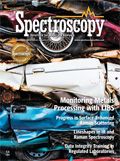Applying LIBS to Metals Processing
Spectroscopy
The monitoring of the processes in steel and metal industry calls for techniques that are capable of measuring the composition of metallic alloys at a distance and on moving conveyor belts. In many cases, such as in the recycling of automotive scrap, the geometry of the objects to be analyzed can vary, and surface coatings can be present. In this paper, we discuss the application of LIBS to two industrial projects to illustrate how the above-mentioned problems can be faced and successfully resolved.
The monitoring of the processes in the steel and metal industry calls for techniques that are capable of measuring the composition of metallic alloys at a distance and on moving conveyor belts. In many cases, such as in the recycling of automotive scrap, the geometry of the objects to be analyzed can vary, and surface coatings can be present. In this column installment, we discuss the application of laser-induced breakdown spectroscopy (LIBS) to two industrial projects to illustrate how the above-mentioned problems can be faced and successfully resolved.
Laser-induced breakdown spectroscopy (LIBS) (1) is an analytical technique that has recently been applied to determining the composition of materials of interest in many fields, such as industry (2â5), environment (6â8), biomedicine (9,10), forensic science (11â13), cultural heritage (14â16), and archaeology (17,18).
LIBS is an elemental technique, and therefore it is particularly suited for the analysis of metals (2â4). Its relatively poor analytical performances (19,20) with respect to the typical laboratory techniques used in the field, in conjunction, on the other hand, with its capability of operating in situ, remotely, and without any treatment of the samples, suggests that the ideal application of LIBS is in the field of in situ analysis and, in particular, industrial processes monitoring.
The Applied and Laser Spectroscopy Laboratory in Pisa, Italy, has participated in a number of projects for the development of prototypes and procedures for efficient monitoring of industrial processes. Some examples include the analysis of steel pipes at high temperatures (CE Project LIBSGRAIN [21]), precious alloys in the recycling industry (22), and exhaust gases from electrical power plants (23).
Our laboratory is currently involved in two important projects that have several points in common: Both of them are related to the analysis of metals in an industrial environment by LIBS. The first project is called laser-based continuous monitoring and resolution of steel grades in sequence casting machines (LACOMORE) started last year with the funding of the European Commission in the framework of the Research Fund for Coal and Steel. The purpose of the LACOMORE project is to accurately model the sequential cast process (24) and experimentally determine the variation of the steel composition during the process using LIBS technology. The second project, called selective recovery of nonferrous metal automotive shredder by combined electromagnetic tensor spectroscopy and laser-induced plasma spectroscopy (SHREDDERSORT), was founded by the European Commission in the 7th Research Framework. The purpose of this project is aimed at developing a new dry sorting technology for nonferrous automotive shredders.
In this column installment, we compare the specific requirements of the LIBS experimental apparatus for these two cases and outline the strategies that are similar in the two applications, as well as the different implementation of the LIBS technology in the each case.
Comparison of the Experimental StrategiesExperimental Strategy for Remote Measurements
In both of the two industrial applications of the LIBS technology, the target of the measurement is moving at a steady speed. However, in the LACOMORE case the geometry of the measurement is fixed (the height and lateral dimensions of the slab or billet are always the same), while in the SHREDDERSORT situation the size and shape of the scraps vary greatly on the conveyor belt, which moves much faster (4 m/s) with respect to the LACOMORE case (1.5 m/min).
Thus, the measurements strategies are different. In both cases, the experimental constraints impose the need for remote measurements; for the LACOMORE application, a single laser system is used, given the fixed geometry of the analysis. The LIBS system is a variation of the stand-off LIBS instrument realized by the Laserna group at the University of Malaga (25), which has been successfully tested in the typical conditions of the steel plants where the prototype will be installed (5-m distance between the laser and the target, with a target temperature around 900 °C). In the Malaga LIBS instrument, the laser beam is focused using a high-power beam expander on the steel slab or billet surface. The laser beam energy is 400 mJ in 5-ns pulses (full width at half maximum [FWHM]), with a repetition rate of 10 Hz.
In the SHREDDERSORT case, on the other hand, the automotive scraps do not always pass the measurement point in the same position, so the experimental strategy in this case is based on the use of a battery of several low-cost lasers that fire only when the scrap passes in the corresponding position of the conveyor belt (see Figure 1). The lasers provide an energy of 1 mJ in 2-ns FWHM pulses, with a repetition rate of 10 Hz.
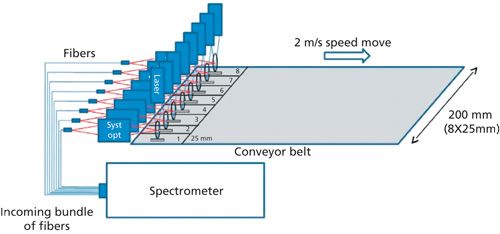
The distance between the laser and the sample is 70 cm on average, and the laser beams are focused with long-focal-length lenses to maximize the depth of field. In fact, the variation in the heights of the samples and, consequently, in the distance between the lens and the sample surface, does not allow for a tight focusing of the laser beam.
Light Collection and Spectral Separation
The LIBS instrument that is used for the LACOMORE application collects the LIBS signal using a Cassegrain telescope (25). In the SHREDDERSORT application, on the other hand, the light is collected by a set of lenses (one per laser) and sent, through a bundle of optical fibers, to the spectrometer. Both in the LACOMORE and SHREDDERSORT applications, the emission lines of the main elements of interest span all the spectrum from near ultraviolet (UV) to near infrared (NIR); therefore the use of a broadband spectrometer is necessary. To guarantee the robustness of the equipment and reduce its costs, the spectral resolution of the spectrometer is not particularly high (0.1 nm between 190 and 450 nm, 0.3 nm from 450 to 900 nm) without intensification, but it is possible to trigger the spectral acquisition at a given delay after the laser pulse to optimize the signal-to-noise ratio (26).
Representativeness of the Signal and Its Enhancement
The maximum repetition rate of the laser used for both the SHREDDERSORT and LACOMORE applications is 10 Hz. While in the LACOMORE case the steel slab or billet moves at the typical speeds of a few meters per minute, which allows a very accurate sampling of the steel composition with a spatial resolution of a few hundreds of micrometers (higher than the one allowed by the dimension of the laser spot on the sample), the analysis and sorting of automotive scraps in SHREDDERSORT must necessarily be based on the result of a single LIBS spectrum. In fact, the distance traveled on the conveyor belt by a scrap between two consecutive measurements would be 20 cm (assuming a speed of the conveyor belt of 2 m/s) to be compared with the average size of the scraps, which is on the order of 10 cm. The problem of the representativeness of the LIBS signal, therefore, is a major concern, especially in view of the presence of dirt or coating at the surface of the scraps. Measurements performed at our laboratory demonstrated that in some cases the LIBS signal does not stabilize before 50â60 shots (in the same spot). This corresponds to a depth of the coating layer of about 100 mm. Moreover, also the signal fluctuations can be very high (see Figure 2).
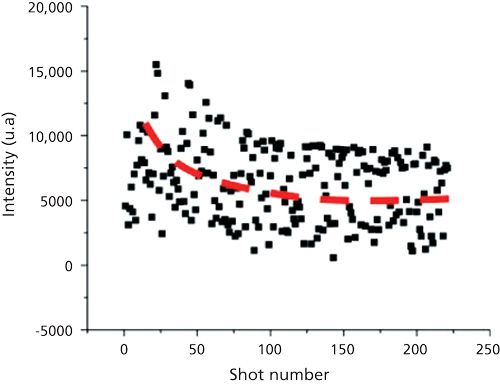
For enhancing the signal and background ratio and, at the same time, increasing the depth of analysis of a single laser measurement, the lasers used in the SHREDDERSORT application are operated in double-pulse mode (27). The use of a collinear double-pulse configuration offers a number of advantages in terms of signal quality and stability; the comparison between two spectra, acquired in single- and double-pulse mode, is shown in Figure 3.
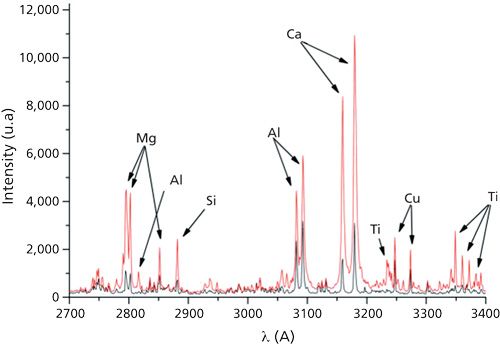
Typical signal enhancements of a factor of three for aluminum and five for magnesium, are obtained in double-pulse configuration using the optimum delay between first and second laser pulse, which is around 2 µs, as shown in Figure 4 for magnesium.
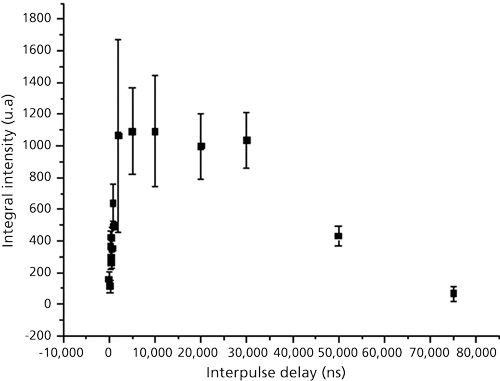
At delays longer than the optimum, the signal enhancement remains important up to 30 µs before decreasing slowly up to reach the level of 0 delay (single pulse) at an interpulse delay around 75 µs.
The signal enhancement and stabilization given by the use of the double-pulse LIBS setup suggested its use also in the LACOMORE application. Also in the case of steel, the signal enhancement is maximum at an interpulse delay of about 1â2 µs (28). At these interpulse delays, the movement of the sample is minimal between the first and second pulse, even in the SHREDDERSORT application, where the conveyor belt moves at a speed of 2 m/s. It has been demonstrated that the double-pulse analysis, in these conditions, is as effective as in the case of a steady sample (29).
An additional benefit of the double-pulse strategy is that the first laser pulse has the effect of cleaning the surface that is analyzed by the second laser pulse, and this is particularly useful in the presence of surface dirt (SHREDDERSORT) or oxide scales (LACOMORE).
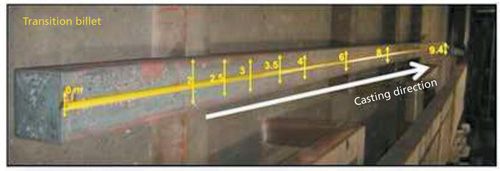
Quantitative Analysis of the LIBS Spectra
The number of LIBS spectra to be analyzed in a typical LIBS application to the on-line analysis of metallic samples is huge. In 1 h of measurements, 36,000 spectra-each typically containing information about more than 5000 wavelengths-are accumulated, at a laser repetition rate of 10 Hz.
Moreover, the LIBS spectra are, by their nature, extremely variable in response to changes in the physical parameters of the plasma-that is, ablated mass, electron number density, and electron temperature-which in an industrial environment reflect the unavoidable variations in the laser energy delivered to the sample because of laser energy fluctuations or changes in the laser focusing on the surface. The use of analytical procedures that are at the same time precise, robust, and fast is, thus, of paramount importance.
A method that fulfills all of these requirements is the LIBS spectral analysis based on the use of artificial neural networks (ANN) (30â32). This method has been proposed recently in several research papers (33â38) because of the quickness and robustness of the algorithms and the availability of specialized commercial and open-source software. The idea at the basis of most of the ANN applications to the analysis of LIBS spectra is, in fact, the construction of a nonlinear combination of a given number of inputs (LIBS spectral intensities), optimized for obtaining the best representation of a set of outputs (elemental concentrations) on a number of known samples (training). The coefficients of this multivariate, nonlinear combination, after a proper validation and testing, can be used for calculating the desired outputs from a set of inputs obtained on unknown samples (prediction).
In the LACOMORE application, the use of ANN has allowed the precise reconstruction of the variation of the concentration of some key elements in the transition layer between two consecutive grades (see Figure 6).

The ANN method allows the statistical analysis of the LIBS spectra one by one, providing the additional information that the steel composition in the transition layer is highly inhomogeneous. This suggests the possibility that the mixing of the two grades, in the transition layer, is not perfect. A model of the mixing process should thus take into account of this effect.
In the SHREDDERSORT application, on the other hand, the determination of the precise composition of the scraps is not very important, while it is important to perform a quick sorting of the nonferrous portion of the scraps (about 8% of the total weight in the automotive shredder) separating, for example, wrought from cast aluminum. It is worth noting that none of the current sorting technologies are able to successfully sort the light fraction of the metals (Al and Mg) into individual alloys, which consequently must be downgraded to produce cast aluminum.
Figure 7 shows the results of the sorting of 21 aluminum scraps of known characteristics (wrought or cast) on the basis of the LIBSâANN analysis. The experimental discriminant between cast and wrought alloys is the concentration of silicon (wrought alloys should contain silicon at a considerably lower concentration).
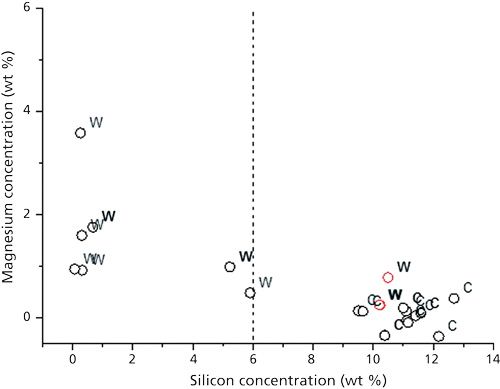
The samples analyzed in Figure 7 are real scraps (dirty and sometimes coated); therefore, some of the wrought aluminum samples are misclassified as cast. The samples of wrought alloys misclassified as cast are not particularly problematic, since this misclassification only affects the efficiency of the process, without compromising the quality of the recovered wrought material. In fact, the presence of a surface contamination in general would increase the concentration of silicon, which is also present in some dirt, at the sample surface. Consequently, it is highly improbable that a cast alloy would be classified as wrought.
Conclusions
In this column installment, we have shown that LIBS can be successfully applied to the monitoring of processes in the metal industry. The cases of steel production and automotive scrap sorting and recovery were presented. The measurement strategies can be different according to the specific situation; however, the recurring need for remote analysis of moving targets favors the use of methods that improve the signal and background ratio in the LIBS spectra and for fast and robust analytical techniques capable of determining the sample composition on the basis of a single LIBS spectrum. These requirements strongly suggest the use of a collinear double-pulse LIBS configuration and ANN analysis of the obtained spectra. The results presented demonstrate that this approach is appropriate for the scope of the analysis.
Acknowledgments
The research reported in this column was partially funded by the European Commission through the LACOMORE (laser-based continuous monitoring and resolution of steel grades in sequence casting machines) project in the framework of the RFCS Research Fund for Coal and Steel and the SHREDDERSORT (selective recovery of non-ferrous metal automotive shredder by combined electromagnetic tensor spectroscopy and laser-induced plasma spectroscopy) project in the 7th Framework Programme.
References
(1) A. Miziolek, V. Palleschi, and I. Schechter, Laser Induced Breakdown Spectroscopy (Cambridge University Press, Cambridge, UK, 2006).
(2) R. Noll, H. Bette, A. Brysch, M. Kraushaar, I. Mönch, L. Peter, and V. Sturm, Spectrochim. Acta B 56(6), 637â649 (2001).
(3) J. Gurell, A. Bengtson, M. Falkenström, and B.A.M. Hansson, Spectrochim. Acta B74â75, 46â50 (2012).
(4) P. Werheit, C. Fricke-Begemann, M. Gesing, and R. Noll, J. Anal. At. Spectrom.26(11), 2166â2174 (2011).
(5) Ã. Aydin, J. Makowe, and R. Noll, VDI Berichte1844, 401â412, 471 (2004).
(6) M. Casini, M.A. Harith, V. Palleschi, A. Salvetti, D.P. Singh, and M. Vaselli, Laser and Particle Beams 9(2), 633â639 (1991).
(7) R.T. Wainner, R.S. Harmon, A.W. Miziolek, K.L. McNesby, and P.D. French, Spectrochim. Acta B56(6), 777â793 (2001).
(8) S. Pandhija, N.K. Rai, A.K. Rai, and S.N. Thakur, Appl. Phys. B 98(1), 231â241 (2010).
(9) V.K. Singh and A.K. Rai, Lasers in Medical Science 26(5), 673â687 (2011).
(10) V. Motto-Ros, L. Sancey, X.C. Wang, Q.L. Ma, F. Lux, X.S. Bai, G. Panczer, O. Tillement, and J. Yu, Spectrochim. Acta B 87, 168â174 (2013).
(11) M.B. Rosenberg and C.R. Dockery, Appl. Spectrosc.62(11), 1238â1241 (2008).
(12) M. Tofanelli, L. Pardini, M. Borrini, F. Bartoli, A. Bacci, A. D’Ulivo, E. Pitzalis, M.C. Mascherpa, S. Legnaioli, G. Lorenzetti, S. Pagnotta, G.H. Cavalcanti, M. Lezzerini, and V. Palleschi, Spectrochim. Acta B99, 70â75 (2014).
(13) E.M. Rodriguez-Celis, I.B. Gornushkin, U.M. Heitmann, J.R. Almirall, B.W. Smith, J.D. Winefordner, and N. Omenetto, Anal. Bioanal.Chem.391(5), 1961â1968 (2008).
(14) D. Anglos and V. Detalle, Springer Series in Optical Sciences182, 531â554 (2014).
(15) A. Nevin, G. Spoto, and D. Anglos, Appl.Phys. A 106(2), 339â361 (2012).
(16) M. Castillejo, M. MartÃn, D. Silva, T. Stratoudaki, D. Anglos, L. Burgio, and R.J.H. Clark, J. Mol. Struct.550â551, 191â198 (2000).
(17) M. Ferretti, G. Cristoforetti, S. Legnaioli, V. Palleschi, A. Salvetti, E. Tognoni, E. Console, and P. Palaia, Spectrochim. Acta B62(12), 1512â1518 (2007).
(18) A. Giakoumaki, K. Melessanaki, and D. Anglos, Anal. Bioanal.Chem. 387(3), 749â760 (2007).
(19) E.H. Evans, J.A. Day, W.J. Price, C.M.M. Smith, K. Sutton, and J.F. Tyson, J. Anal. At. Spectrom.18(7), 808â833 (2003).
(20) D.W. Hahn and N. Omenetto, Appl. Spectrosc. 66, 347â419 (2012).
(21) D. Bulajic, G. Cristoforetti, M. Corsi, M.S. Hidalgo, S. Legnaioli, V. Palleschi, A. Salvetti, E. Tognoni, S. Green, D. Bates, A. Steiger, J. Fonseca, J. Martins, J. McKay, B. Tozer, D. Wells, R. Wells, and M.A. Harith, Spectrochim. Acta B57(7),1181â1192 (2002).
(22) S. Legnaioli, G. Lorenzetti, L. Pardini, V. Palleschi, D.M.D. Pace, F.A. Garcia, R. Grassi, F. Sorrentino, G. Carelli, M. Francesconi, F. Francesconi, and R. Borgogni, Spectrochim. Acta B71â72, 123â126 (2012).
(23) M. Corsi, V. Palleschi, A. Salvetti, and E. Tognoni, Clean Air3(1), 69â79 (2002).
(24) J. Campbell, Complete Casting H, and Book: Metal Casting Processes, Techniques, and Design (Elsevier Butterworth-Heinemann, UK, 2011).
(25) I. Gaona, J. Moros, and J.J. Laserna, J. Anal. At. Spectrom.28(11), 1750â1759 (2013).
(26) E. Grifoni, S. Legnaioli, M. Lezzerini, G. Lorenzetti, S. Pagnotta, and V. Palleschi, J. Spectrosc. doi:10.1155/2014/849310 (2014).
(27) V.I. Babushok, F.C. DeLucia Jr., J.L. Gottfried, C.A. Munson, and A.W. Miziolek, Spectrochim. Acta B61(9), 999â1014 (2006).
(28) S. Legnaioli, G. Lorenzetti, L. Pardini, G.H. Cavalcanti, and V. Palleschi, Springer Series in Optical Sciences182, 117â141 (2014).
(29) G. Cristoforetti, S. Legnaioli, V. Palleschi, E. Tognoni, and P.A. Benedetti, Appl. Phys. A98(1), 219â225 (2010).
(30) S.S. Haykin, Neural Networks: A Comprehensive Foundation, Second Edition (Prentice-Hall, New Jersey, 1999).
(31) L.I. Kuncheva, Combining Pattern Classifiers: Methods, and Algorithms (Wiley Interscience, New Jersey, 2004).
(32) R. Mikut, and M. Reischl, Data Mining Tools, WIREs Data Mining, and Knowledge Discovery (John Wiley & Sons, Inc., 2011).
(33) J.O. Caceres, S. Moncayo, J.D. Rosales, F.J.M. De Villena, F.C. Alvira, and G.M. Bilmes, Appl. Spectrosc.67(9),1064â1072 (2013).
(34) J. El Haddad, M. Villot-Kadri, A. Ismaël, G. Gallou, K. Michel, D. Bruyère, V. Laperche, L. Canioni, and B. Bousquet, Spectrochim. Acta B79â80, 51â57 (2013).
(35) J. El Haddad, D. Bruyère, A. Ismaël, G. Gallou, V. Laperche, K. Michel, L. Canioni, and B. Bousquet, Spectrochim. Acta B97(1), 57â64 (2014).
(36) G. VÃtková, K. Novotný, L. ProkeÅ¡, A. Hrdlicka, J. Kaiser, J. Novotný, R. Malina, and D. Prochazka, Spectrochim. Acta B73, 1â6 (2012).
(37) E. D’Andrea, S. Pagnotta, E. Grifoni, G. Lorenzetti, S. Legnaioli, V. Palleschi, and B. Lazzerini, Spectrochim. Acta B99, 52â58 (2014).
(38) S. Pagnotta, E. Grifoni, S. Legnaioli, M. Lezzerini, G. Lorenzetti, and V. Palleschi, Spectrochim. Acta B 103â104, 70â75 (2015).

Emanuela Grifoni has a Master degree in Science for Cultural Heritage from the University of Padoa, with a thesis about diagnostic analysis on Beato Angelico’s painting. Since February 2013, she has been a PhD student in the Science of Cultural Heritage Conservation at the University of Florence, in collaboration with ICCOM-CNR in Pisa. Her research interests include XRF spectroscopy, multispectral imaging, and other techniques applied to Cultural Heritage.
Vincenzo Palleschi is with the Applied and Laser Spectroscopy Laboratory (ICCOM-

CNR) in Pisa, Italy and the National Interuniversity Consortium of Materials Science and Technology (INSTM). He graduated in Physics with distinction in 1984 at Pisa University. Since September 1988 he has worked as a researcher at Italian National Research Council (CNR) in Pisa, at Institute of Atomic and Molecular Physics, then at Institute for Chemical-Physical Processes and since September 2010 at Institute of Chemistry of Organometallic Compounds. Currently, he is responsible of the activities of the applied and laser spectroscopy laboratory. He has published more than 160 papers in the field of laser spectroscopy that received more than 3700 citations (H-index 34) and authored the PCT/EP Patent #99/01842. He is chief editor of the Journal of Applied and Laser Spectroscopy and member of the editorial boards of the journals Spectrochimica Acta B and Reviews in Analytical Chemistry. He is a member of the Scientific Committee of the Center for Ancient Mediterranean and Near Eastern Studies.
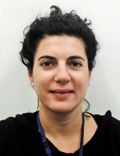
Giulia Lorenzetti has a Masters degree and a PhD in Science for Cultural Heritage from the University of Florence, with a thesis on confocal Raman spectroscopy. Since 2012 she has been a research fellow at ICCOM-CNR. Her research includes plasma (LIBS) and Raman spectroscopy techniques applied to cultural heritage. She is also contributing to the development of an algorithm for the automatic element detection in LIBS spectra.

Stefano Pagnotta has a bachelor degree in Conservation of Cultural Heritage from Suor Orsola Benincasa University and a master degree in archaeology from Pisa University. Since 2015, he has had a scholarship at the Institute of chemistry of organometallic compounds ICCOM-CNR Research Area of Pisa, in spectroscopic methods for the analysis of matrix materials inhomogeneous. His main interests are applied laser spectroscopy, X-ray fluorescence, multispectral imaging and colorimetry, archaeometry and pottery analysis.

Stefano Legnaioli graduated in physics and obtained a PhD in the Science of Cultural Heritage Conservation (chemical sciences) at the University of Florence. In 2011, he received a Master degree in Innovation and Knowledge Transfer (MIT) at the School of Management MIP, Politecnico of Milano. He was enrolled as Researcher at the Institute of Chemistry of Organo-Metallic Compound (ICCOM-CNR) in Pisa, working in several research activities of the applied laser spectroscopy group, particularly in the field of spectroscopic techniques applied to cultural heritage (pigment analysis, analysis of ceramics, archeo-metallurgy, and more), environmental, bio-medicine, and material characterization such as monitoring of industrial processes.
Correction
In the version of this article that appeared in print, incorrect units were specified in several sentences on page 24. The corrected paragraphs are shown below:
Typical signal enhancements of a factor of three for aluminum and five for magnesium, are obtained in double-pulse configuration using the optimum delay between first and second laser pulse, which is around 2 µs, as shown in Figure 4 for magnesium.
At delays longer than the optimum, the signal enhancement remains important up to 30 µs before decreasing slowly up to reach the level of 0 delay (single pulse) at an interpulse delay around 75 µs.
The signal enhancement and stabilization given by the use of the double-pulse LIBS setup suggested its use also in the LACOMORE application. Also in the case of steel, the signal enhancement is maximum at an interpulse delay of about 1â2 µs (28). At these interpulse delays, the movement of the sample is minimal between the first and second pulse, even in the SHREDDERSORT application, where the conveyor belt moves at a speed of 2 m/s. It has been demonstrated that the double-pulse analysis, in these conditions, is as effective as in the case of a steady sample (29).
